《数字图像处理》课程教学课件(Digital Image Processing)图像压缩——图像压缩基本概念

Digital Image Processing Chapter 8: Image Compression-1
Digital Image Processing Chapter 8: Image Compression-1

Outline 1 Fundamentals 2 Some basic compression method ·Huffman coding ·Arithmetic coding ·LZW coding Block Transform coding ·Predictive coding
Outline 1 Fundamentals 2 Some basic compression method • Huffman coding • Arithmetic coding • LZW coding • Block Transform coding • Predictive coding • …
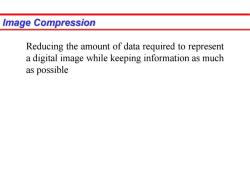
Image Compression Reducing the amount of data required to represent a digital image while keeping information as much as possible
Reducing the amount of data required to represent a digital image while keeping information as much as possible Image Compression
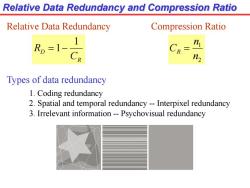
Relative Data Redundancy and Compression Ratio Relative Data Redundancy Compression Ratio R=1- n R n, Types of data redundancy 1.Coding redundancy 2.Spatial and temporal redundancy--Interpixel redundancy 3.Irrelevant information--Psychovisual redundancy
Relative Data Redundancy and Compression Ratio R D C R 1 1 Relative Data Redundancy Compression Ratio 2 1 n n CR Types of data redundancy 1. Coding redundancy 2. Spatial and temporal redundancy -- Interpixel redundancy 3. Irrelevant information -- Psychovisual redundancy

Coding Redundancy Different coding methods yield different amount of data needed to represent the same information. Example of Coding Redundancy Variable Length Coding vs.Fixed Length Coding Tk Pr(rk) Code 1 11(rk) Code2 12(Tk) T87=87 0.25 01010111 8 01 2 7128=128 0.47 10000000 8 1 7186=186 0.25 11000100 8 000 3 255=255 0.03 11111111 8 001 3 rk for k≠87,128,186,255 0 一 8 0 Lav8 bits/symbol Lavg 1.81 bits/symbol Concept:assign the longest code word to the symbol with the least probability of occurrence
Coding Redundancy Different coding methods yield different amount of data needed to represent the same information. Example of Coding Redundancy : Variable Length Coding vs. Fixed Length Coding Lavg 8 bits/symbol Lavg 1.81 bits/symbol Concept: assign the longest code word to the symbol with the least probability of occurrence

Spatial and temporal Redundancy Interpixel redundancy: Parts of an image are highly correlated. In other words,we can predict a given pixel from its neighbor. nk P(rk) 1 256 256 o 50 100 150 200 250
Spatial and temporal Redundancy Interpixel redundancy: Parts of an image are highly correlated. In other words,we can predict a given pixel from its neighbor
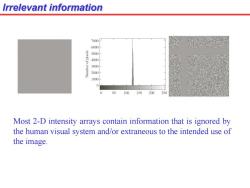
Irrelevant information 7000 6000 5000 00 30 00 1000 0 0 100150200250 Most 2-D intensity arrays contain information that is ignored by the human visual system and/or extraneous to the intended use of the image
Irrelevant information Most 2-D intensity arrays contain information that is ignored by the human visual system and/or extraneous to the intended use of the image
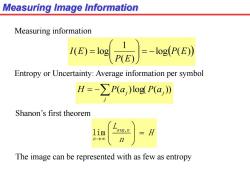
Measuring Image Information Measuring information I(E)=log =-log(P(E)) Entropy or Uncertainty:Average information per symbol H=-∑P(a,)logP(a,》 Shanon's first theorem lim avg,n The image can be represented with as few as entropy
Measuring Image Information Measuring information log ( ) ( ) 1 ( ) log P E P E I E Entropy or Uncertainty: Average information per symbol j H P aj P aj ( )log( ( )) Shanon’s first theorem The image can be represented with as few as entropy , lim avg n n L H n

Fidelity Criteria:how good is the compression algorithm -Objective Fidelity Criterion RMSE,PSNR -Subjective Fidelity Criterion: -Human Rating Value Rating Description 1 Excellent An image of extremely high quality,as good as you could desire. 2 Fine An image of high quality.providing enjoyable viewing.Interference is not objectionable. 3 Passable An image of acceptable quality.Interference is not objectionable. 4 Marginal An image of poor quality;you wish you could improve it.Interference is somewhat objectionable. 5 Inferior A very poor image,but you could watch it. Objectionable interference is definitely present. Unusable An image so bad that you could not watch it
Fidelity Criteria: how good is the compression algorithm -Objective Fidelity Criterion - RMSE, PSNR -Subjective Fidelity Criterion: -Human Rating
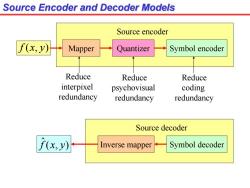
Source Encoder and Decoder Models Source encoder f(x,y) Mapper Quantizer Symbol encoder Reduce Reduce Reduce interpixel psychovisual coding redundancy redundancy redundancy Source decoder 子(x,y) Inverse mapper Symbol decoder
Source Encoder and Decoder Models f (x, y) Mapper Quantizer Symbol encoder Source encoder Inverse mapper Symbol decoder Source decoder ( , ) ˆ f x y Reduce interpixel redundancy Reduce psychovisual redundancy Reduce coding redundancy
按次数下载不扣除下载券;
注册用户24小时内重复下载只扣除一次;
顺序:VIP每日次数-->可用次数-->下载券;
- 《数字图像处理》课程教学课件(Digital Image Processing)彩色图像处理 6.2 伪彩色和全彩色图像处理.pdf
- 《数字图像处理》课程教学课件(Digital Image Processing)彩色图像处理 6.1 彩色基础和彩色模型.pdf
- 电子工业出版社:《数字图像处理》书籍教材PDF电子版(中译第三版)第6章 彩色图像处理.pdf
- 《数字图像处理》课程教学课件(Digital Image Processing)图像复原与重建 5.7 逆滤波 5.8 维纳滤波.pdf
- 《数字图像处理》课程教学课件(Digital Image Processing)图像复原与重建 5.5 退化函数的估计 5.6 逆滤波.pdf
- 《数字图像处理》课程教学课件(Digital Image Processing)图像复原与重建 5.3 空间域滤波方法 5.4 频率域滤波方法.pdf
- 《数字图像处理》课程教学课件(Digital Image Processing)图像复原与重建 5.1 图像退化复原过程的模型 5.2 噪声模型.pdf
- 电子工业出版社:《数字图像处理》书籍教材PDF电子版(中译第三版)第5章 图像复原与重建.pdf
- 《数字图像处理》课程教学课件(Digital Image Processing)频率域滤波 4.9 使用频率域滤波器锐化图像.pdf
- 《数字图像处理》课程教学课件(Digital Image Processing)频率域滤波 4.8 频率域平滑图像(频域平滑滤波器).pdf
- 《数字图像处理》课程教学课件(Digital Image Processing)频率域滤波 4.7 频率域滤波基础.pdf
- 《数字图像处理》课程教学课件(Digital Image Processing)频率域滤波 4.6 二维离散傅里叶变换的性质.pdf
- 《数字图像处理》课程教学课件(Digital Image Processing)频率域滤波 4.4 单变量的离散傅立叶变换 4.5 两个变量的扩展.pdf
- 《数字图像处理》课程教学课件(Digital Image Processing)频率域滤波 4.3 取样和取样函数的傅里叶变换.pdf
- 《数字图像处理》课程教学课件(Digital Image Processing)频率域滤波 4.2 基本概念.pdf
- 《数字图像处理》课程教学课件(Digital Image Processing)频率域滤波 4.1 背景——傅立叶级数和变换简史.pdf
- 电子工业出版社:《数字图像处理》书籍教材PDF电子版(中译第三版)第4章 频率域滤波.pdf
- 《数字图像处理》课程教学课件(Digital Image Processing)灰度变换与空间滤波 3.3 空间滤波 Fundamentals of spatial filtering.pdf
- 《数字图像处理》课程教学课件(Digital Image Processing)灰度变换与空间滤波 3.2 直方图 Histogram processing.pdf
- 《数字图像处理》课程教学课件(Digital Image Processing)灰度变换与空间滤波 3.1 邻域 邻接、连接 区域、边界 距离.pdf
- 《数字图像处理》课程教学课件(Digital Image Processing)图像压缩 ——霍夫曼-算术-LZW编码.pdf
- 《数字图像处理》课程教学课件(Digital Image Processing)图像压缩——变换编码.pdf
- 电子工业出版社:《数字图像处理》书籍教材PDF电子版(中译第三版)第9章 形态学图像处理.pdf
- 电子工业出版社:《数字图像处理》书籍教材PDF电子版(中译第三版)第10章 图像分割.pdf
- 电子工业出版社:《数字图像处理》书籍教材PDF电子版(MATLAB版)Digital Image Processing Using MATLAB【美】Richard E.Woods Steven L.Eddins(共十二章).pdf
- 《软件工程》课程教学资源(书籍教材)英文电子版《软件工程——实践者之路》第九版 Software Engineering, A Practitioners Approach(9th Ed, Roger S. Pressman, Ph.D. Bruce R. Maxim, Ph.D., 2019).pdf
- 南方医科大学:《软件工程》课程教学大纲 Software Engineering.pdf
- 南方医科大学:《软件工程》课程教学资源(PPT课件)第1章 软件工程概述(主讲:杨谊).pptx
- 南方医科大学:《软件工程》课程教学资源(PPT课件)第2章 软件过程.pptx
- 南方医科大学:《软件工程》课程教学资源(PPT课件)第3章 结构化分析 3.1 软件开发计划 3.2 需求分析的内容.pptx
- 南方医科大学:《软件工程》课程教学资源(PPT课件)第3章 结构化分析 3.3 分析建模与规格说明 3.4 实体-关系图 3.5 数据流图 3.6 状态转换图 3.7 数据字典.pptx
- 南方医科大学:《软件工程》课程教学资源(PPT课件)第4章 结构化设计 4.1 什么是软件设计 4.2 设计的概念和原理 4.3 模块独立 4.4 启发规则 4.5 表示软件结构的图形工具 4.6 面向数据流的设计.pptx
- 南方医科大学:《软件工程》课程教学资源(PPT课件)第4章 结构化设计 4.7 人机界面设计 4.8 详细设计的方法和工具 4.8 过程设计的方法和工具 4.10 面向数据结构的设计方法.pptx
- 南方医科大学:《软件工程》课程教学资源(PPT课件)第5章 结构化实现 5.1 编码与程序语言.pptx
- 南方医科大学:《软件工程》课程教学资源(PPT课件)第5章 结构化实现 5.2 算法决策.pptx
- 南方医科大学:《软件工程》课程教学资源(PPT课件)第5章 结构化实现 5.3 测试(原则,方法,技术)5.4 调试.pptx
- 南方医科大学:《软件工程》课程教学资源(PPT课件)第6章 面向对象方法学导论.ppt
- 南方医科大学:《软件工程》课程教学资源(PPT课件)第7章 面向对象分析.ppt
- 南方医科大学:《软件工程》课程教学资源(PPT课件)第8章 面向对象设计(1/2).ppt
- 南方医科大学:《软件工程》课程教学资源(PPT课件)第8章 面向对象设计(2/2).ppt
